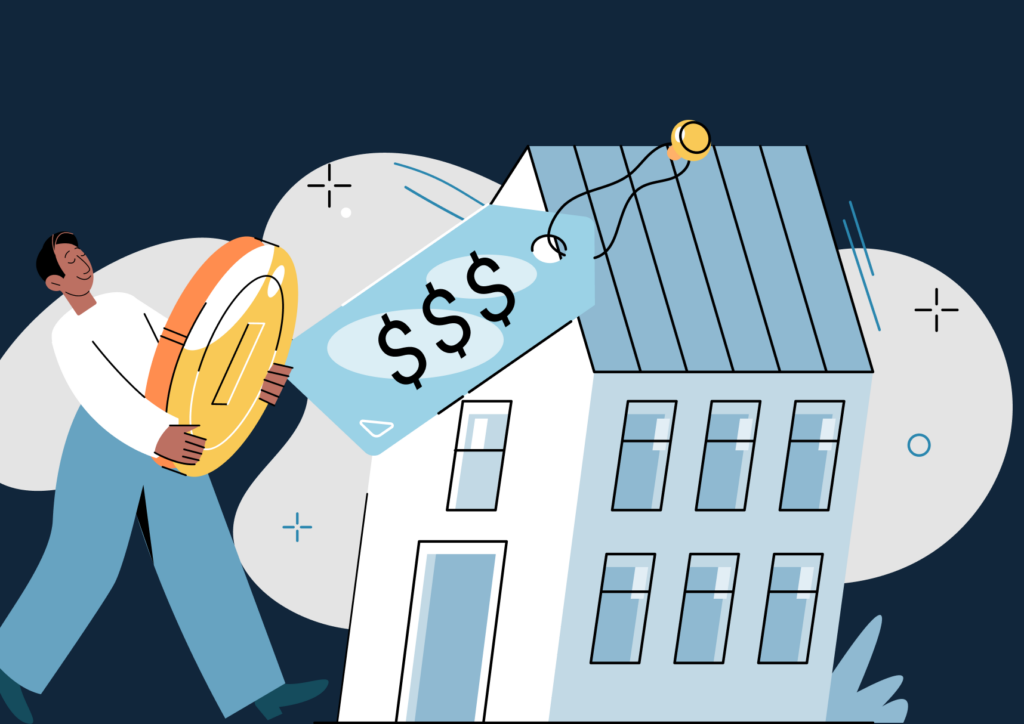Capital Growth VS Rental Yield

Two key concepts that guide investor decisions are capital growth and rental yield.
Both play pivotal roles in shaping the profitability and success of real estate investments, but they do so in different ways.
Capital growth, or capital appreciation, refers to the increase in value of a property over time. It’s the profit you make when you sell the property for more than you paid.
Rental yield, on the other hand, is the annual rental income generated by the property, expressed as a percentage of the property’s value.
Understanding the difference and balance between capital growth and rental yield is essential for making informed investment decisions.
Some investors might prioritize immediate, steady income (high rental yield), while others may focus on the long-term increase in the property’s value (capital growth). The ideal investment strategy often depends on individual financial goals, market conditions, and risk tolerance.
This blog post aims to delve into these two crucial aspects of property investment, helping you chart a path that aligns with your investment objectives.
Understanding capital growth

Capital growth, or capital appreciation, is a fundamental concept in property investment, denoting the increase in the market value of a property over time.
Capital growth is realized when the value of a property increases. This can occur due to a variety of factors, including market demand, developments in the area, or improvements made to the property itself.
In real estate, capital appreciation represents the difference between the purchase price of a property and its current or selling price.
For instance, if you buy a property for £200,000 and sell it five years later for £250,000, the capital growth is £50,000.
Factors influencing capital growth:
- Market Trends: The overall health of the real estate market greatly influences capital growth. A booming market generally leads to higher property values.
- Location: Properties in sought-after locations or areas undergoing regeneration often experience significant capital growth.
- Economic Conditions: Interest rates, employment rates, and the overall economic environment impact property prices. For example, low interest rates often lead to increased buying activity, pushing property prices up.
- Developments and Infrastructure: New developments, transportation links, schools, and amenities can make an area more desirable, leading to increased property values.
Downsides of investing for capital growth
- Capital growth is highly dependent on property market fluctuations. Economic downturns, changes in housing policies, or shifts in market demand can lead to a decrease in property values, impacting the expected capital growth.
- Capital growth typically requires a long-term investment outlook. It might take several years to see significant appreciation in property value, which may not suit investors seeking short-term gains or regular income.
- Purchasing properties with high capital growth potential often involves a substantial initial investment, including down payment, stamp duty, legal fees, and possibly renovation costs.
- Owning a property comes with ongoing maintenance costs, property taxes, and possibly management fees, which can erode profit margins if the property doesn’t appreciate as expected.
- If the property market experiences a downturn, you could find yourself in a situation where the value of your property is less than the mortgage, known as negative equity.
- Capital growth is influenced by broader economic factors such as employment rates, interest rates, and overall economic health, which are beyond an investor’s control.
- Capital gains tax may apply when you sell the property for a profit, which can reduce the overall return on your investment.
- To maximize returns, you must strategically time the sale of the property. Selling too early or during a market slump can significantly reduce your capital gains.
Understanding rental yield
Rental yield represents the return on investment from rental income.
Rental yield is the annual rental income generated by a property, expressed as a percentage of the property’s purchase price or current market value.
To calculate, divide the annual rental income by the property’s value and multiply by 100.
For example, if a property is worth £200,000 and generates £10,000 in rent annually, the rental yield is (10,000 / 200,000) × 100 = 5%.
Rental yield is particularly important for investors who rely on regular income from their property investments, such as retirees or those seeking a steady cash flow.
High rental yield can provide immediate returns on investment, as opposed to waiting for capital growth over a longer period.
Factors affecting rental yield:
- Location: Properties in high-demand areas or city centers tend to have higher rental yields due to greater tenant demand.
- Property Type: Different types of properties attract different rental yields. For instance, smaller apartments might yield higher rents relative to their value compared to larger family homes.
- Tenant Demand: High tenant demand can lead to higher rents and thus higher rental yields. Factors like proximity to universities, transport links, and local amenities can influence demand.
Downsides of investing for rental yields
- Properties with high rental yields often have less potential for capital appreciation compared to those in rapidly growing markets. This means the long-term value increase of the property might be limited.
- Rental markets can be sensitive to economic downturns. In times of economic hardship, the ability to maintain high rental rates or even keep properties occupied can be compromised, affecting the yield.
- Properties with high rental yields, especially in high-demand areas, often require more active management. This includes dealing with tenant turnover, maintenance issues, and administrative tasks.
- Rental properties can face periods of vacancy which directly impact income. These periods can be due to various reasons, including market saturation, off-peak seasons in certain locations, or economic downturns.
- Rental properties require regular maintenance and repairs to keep them appealing to tenants, which can be a significant ongoing cost. Unexpected repairs can also impact the profitability of the investment.
- Dealing with tenants can sometimes be challenging. Issues can range from late payments to damage to the property, leading to potential legal and financial complications.
- As a landlord, there are numerous legal and regulatory obligations to comply with, including safety regulations, tenant rights, and local housing laws. Non-compliance can lead to legal issues and financial penalties.
- Real estate is a relatively illiquid asset class. If you need to access cash quickly, selling a property or finding tenants in a hurry might not be feasible.
- Rental income is subject to taxation, and tax regulations can change, potentially affecting the profitability of rental investments.
- If you have a mortgage on the property, rising interest rates can increase your costs, thus reducing the net yield.
Capital growth vs. rental yield: The balancing act

While both capital growth and rental yield are crucial for property investment, they often require different strategies and priorities.
Capital growth focuses on the long-term increase in property value. It is ideal for investors looking for a significant return upon selling the property. However, it is subject to market volatility and may require a longer investment horizon.
Rental yield concerns the immediate return on investment through rental income. It’s a key measure for investors who need regular cash flow. While less subject to market fluctuations, high rental yields are often found in areas where capital growth potential is limited.
Scenarios for prioritization:
- Prioritizing Capital Growth: An investor with a long-term view, willing to wait for the property’s value to appreciate significantly, might focus on capital growth. Such investors are often less reliant on immediate cash flow.
- Prioritizing Rental Yield: Investors needing regular income or those who are risk-averse might prioritize properties with high rental yields. This is common among retirees or investors who depend on the income to cover mortgages or other expenses.
The choice between focusing on capital growth or rental yield depends largely on individual investment goals, risk tolerance, and financial needs. A balanced investment portfolio can include a mix of properties offering both high rental yields and strong potential for capital growth, catering to both immediate income needs and long-term financial goals.
Aligning investment goals with growth and yield
Here’s how to align your investment strategy with these factors:
1. Understanding Your Financial Objectives:
- For Capital Growth: If your goal is to build wealth over a longer period, capital growth may be your focus. This is suitable for investors who don’t need immediate income from their investments and can afford to wait for the property value to appreciate.
- For Rental Yield: If you require regular income, for instance, to supplement your earnings or retirement income, prioritizing rental yield is advisable. This approach provides a steady cash flow.
2. Assessing Risk Tolerance:
- Capital Growth and Risk: Investing for capital growth involves higher risk due to market volatility. If you have a higher risk tolerance, this could be a suitable strategy.
- Rental Yield and Stability: Rental yield offers more stability and is less influenced by short-term market fluctuations, making it suitable for those with a lower risk tolerance.
3. Considering Investment Horizon: Long-term investments align well with capital growth strategies, while short to medium-term investments may benefit more from focusing on rental yield.
4. Balanced Approach: A diversified portfolio that includes both high-yield properties and those with strong potential for capital growth can provide both immediate income and long-term capital appreciation, catering to different financial needs and market conditions.
Market considerations
Current market trends play a significant role in determining whether to focus on capital growth, rental yield, or a combination of both. Adapting your investment strategy in response to these trends is crucial.
Examining market trends:
Keep abreast of the latest market data, including property price trends, rental market conditions, economic outlook, and interest rate changes.
Consider regional trends, as some areas may offer better potential for capital growth while others might present higher rental yields.
Adapting investment strategies:
In a rising market, focusing on capital growth might be more beneficial, as property values are likely to increase.
In a stable or saturated market, rental yield may be a more reliable investment focus, especially in areas with high rental demand.
Be prepared to shift your strategy in response to major economic changes, such as shifts in housing policies, economic downturns, or significant interest rate changes.
Consider long-term trends and future developments, such as infrastructure projects, which can impact both capital growth and rental yields in the future.
Tips for maximizing both capital growth and rental yield
Balancing capital growth and rental yield is key for a well-rounded property investment portfolio. Here are practical tips for achieving this:
- Strategic property selection:
Choose locations with strong growth potential and high rental demand. Emerging suburbs, areas undergoing regeneration, or those near infrastructure developments are often good choices.Consider properties with unique features or appeal that can attract tenants and also appreciate in value over time. - Adding value to the property:
Invest in renovations or improvements that increase the property’s appeal to tenants and its market value. This could include modernizing kitchens and bathrooms, adding storage, or improving energy efficiency. - Diversify your portfolio:
Diversify across different types of properties and locations. This spreads risk and allows you to benefit from different market conditions. - Stay informed and proactive:
Keep abreast of market trends and property values in your investment areas. Being informed enables timely decisions to sell, buy, or renovate properties. - Effective property management:
Good management can increase rental yields by minimizing vacancies, maintaining the property, and setting competitive rent prices. - Review and adjust:
Regularly review the performance of your properties. Be prepared to adjust your strategy in response to market changes or underperformance.
Conclusion
In the dynamic landscape of property investment, capital growth and rental yield are two fundamental concepts that offer different paths to financial success. Capital growth, focusing on the long-term increase in property value, is ideal for investors looking to build wealth over time. Rental yield, on the other hand, provides immediate, regular income, making it a reliable choice for those who need consistent cash flow.
Key takeaways:
- Balance is Key: A balanced approach that considers both capital growth and rental yield can cater to diverse financial goals and market conditions.
- Market Knowledge: Staying informed about real estate market trends and economic factors is crucial for making informed decisions.
- Risk and Return: Understand your risk tolerance and investment horizon. High-growth areas typically offer lower immediate yields, while high-yield properties may not appreciate as quickly in value.
- Diversification: Diversifying your portfolio across different property types and locations can mitigate risk and capitalize on different market dynamics.
For further exploration and to stay updated on property investment trends, check our investment guides and subscribe to our newsletter.
If you’re looking for a trustworthy partner and someone who can help you navigate through real estate investment, contact us for in-depth advice. Our experts are ready to assist you in maximizing your rental yields and capital growth.


